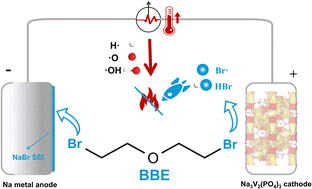Bromide-based nonflammable electrolyte for safe and long-life sodium metal batteries†
Abstract
Sodium metal batteries (SMBs) are one of the most promising energy storage technologies owing to the rich abundance of sodium and its high gravimetric capacity. However, safe applications of SMBs are hindered by reactive sodium metal and the highly flammable electrolyte, which leads to dendritic growth, gassing and fire issues. Here we report a new class of bromide-based nonflammable electrolytes for sodium metal batteries using flame-retardant 2-bromo-1-(2-bromoethoxy)ethane (BBE) solvent. This solvent not only has higher fire retardancy than typical P, Cl, F-based nonflammable solvents owing to the lower energy barrier of radical scavenger dissociation, but also derives a solid electrolyte interphase (SEI) containing NaBr with a high ionic conductivity to suppress the dendrite and gassing issues. The BBE-based electrolyte prolongs the cycle life (80% capacity retention) of Na3V2(PO4)3//Na cells from 60 cycles in traditional electrolytes to 1500 cycles and produces a stable cycle life of 1400 h in the Na//Na symmetric cells. We further demonstrated a sodium metal pouch cell showing a capacity retention of 97.9% after 264 cycles at 1C. This work provides a rational design strategy for improving electrolyte flame retardancy and constructing a stable SEI for safe and long-life sodium metal battery applications.



 Please wait while we load your content...
Please wait while we load your content...